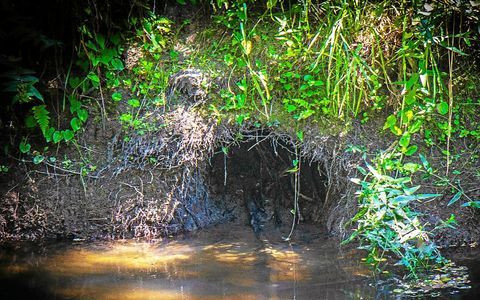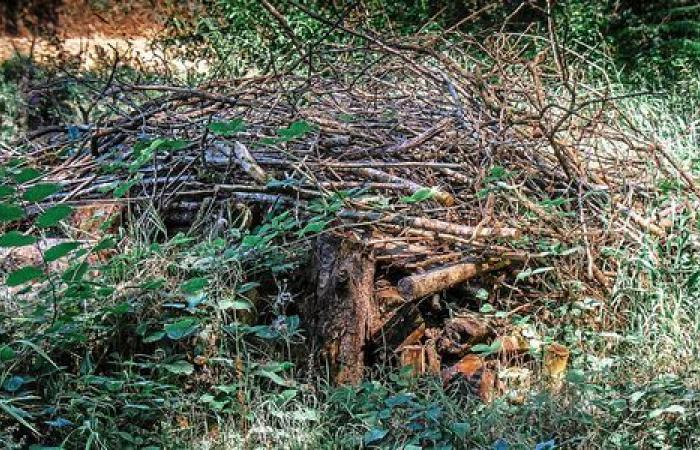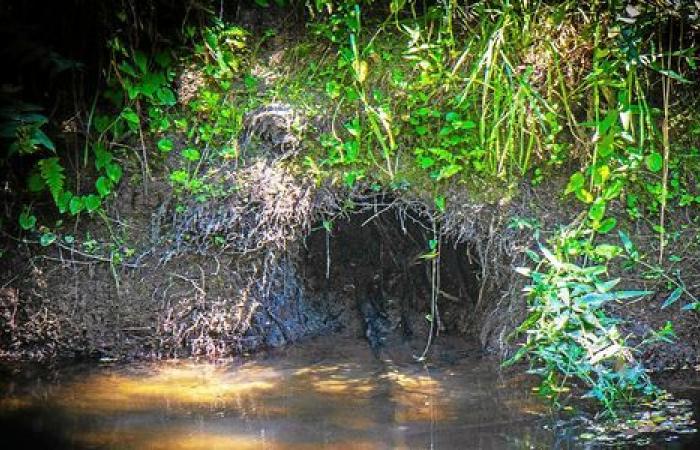Since an individual was spotted near Rives-du-Couesnon in 2022, the town, in a burst of voluntarism, has set up an interpretation trail in his honor. This is where our investigation begins. Panels detail the habits of the elusive mustelid: size, weight, shape, small snout with a perpetually sad and surprised look… To confuse it with a coypu, a stocky rodent with orange teeth, you would really have to do it on purpose.
His droppings would smell of honey and fish
14 h 45.
As in any good thriller, our first stop is a passage under a bridge. Except that, there, it’s daytime, the sun is beating down and the Couesnon is gurgling happily at our feet, teeming with dragonflies and excited gerrids. This place is not just for walkers. It also allows otters to move around without fearing a sudden and definitive encounter with a bumper.
The earth is too dry for footprints. But there, on the bank, sits an oblong, black shape. A turd. Could it be a “print”, the name given to the excrement that the otter leaves when it comes out of the water to mark its passage? These would, swears the GMB, have a smell of honey mixed with fish. Come on, courage, it’s for science: we stick the little gift in a branch and bring it to our nostrils. Ugh! These scents leave no room for the gastronomic imagination. It’s rat droppings.
15 h 05.
We continue our walk, our eyes fixed on the watercourse. Frogs are fleeing our giant galoshes. The vegetation becomes denser. Our footsteps are muffled by a carpet of clover, nettles, hemlock and bindweed. Handfuls of juicy blackberries seek a place in the sun. It would be idyllic without the incessant roar of the nearby Estuaires road. From the ground emerges the tip of a broken fork, like a snook at the time when this instrument was used to flush out otters, hunted both for their fur and for their competition with fishermen (very exaggerated).
Some said she was a child eater! If the otters take so long to return, despite the cessation of hunting, it may also be because only 3% of the department’s water bodies are in good ecological condition, according to 2022 figures from the prefecture. The presence of coypus, vegetarians, does not scare this carnivore either. It is capable of squatting in their nests, although it generally prefers roots and blocks of stone.
15 h 40.
In fact, a pile of branches stands at the side of the road. It is a catiche, an otter’s nest. Too bad: it is artificial, made by a neighboring agricultural high school. The path is muddy and dotted with tracks: dogs, deer and, above all, bicycles. Go find an otter paw in there. But two meters away, a small trench opens in the bank. Barefoot in the muddy water, we crane our necks to try to see something… There! Emptied shells! At the time, we are persuaded to admire the remains of an otter dinner, which does not disdain molluscs. But nothing is less certain, several studies on river inhabitants refute. We would rather be facing the compost of a friendly but banal… muskrat.

16 h 29.
Two walkers are coming in the opposite direction. “We didn’t see an otter!” On the other hand, there was like a dam, a little higher up. We thought of a beaver. Maybe they don’t come out at that time. » The GMB indicates that they are “more nocturnal”. But we are never safe from coming across an insomniac specimen.
17 h.
A group of teenagers are playing in the water at the foot of an old mill. “Otters? one is surprised. You mean coypu, right? » “But no,” said another, “he’s playing a joke on you. We live here, we would have seen them.” The educational trail? “We don’t know,” she giggles. But if you want to see otters so bad, maybe with drugs…? » (Chuckles.) Ah, well, well done! Already there were no otters, now there is no more youth. We leave with the feeling of being that naive tourist who asks a Scot where to come across the Loch Ness monster.
17 h 10.
End of investigation. The sporadic observations of the GMB should not have given us false hope: the presence of the otter in the east of the department is still fragile. Just like his cousin the wolf, another unloved one who attempts incursions into our region. In the meantime, humans can discover the “In search of the catiche” circuit, for example during a picnic on the last Wednesday in May: it will be World Otter Day.








